car headlight bulb guide
Car headlight bulbs are essential for safety and visibility, providing clear illumination for drivers. With various types like halogen, LED, and HID, choosing the right bulb ensures optimal performance and longevity.
Understanding the Importance of Headlight Bulbs
Headlight bulbs are crucial for safety and visibility, enabling drivers to see the road and be seen by others. They illuminate pathways, reducing accidents in low-light conditions. Properly functioning bulbs ensure clear vision, while faulty ones can compromise safety. With types like halogen, LED, and HID, each offers unique benefits in brightness, energy efficiency, and lifespan. Regular maintenance, such as cleaning and alignment, is vital for optimal performance. Upgrading to high-quality bulbs enhances visibility and driving confidence, making them a key component of vehicle safety and reliability.
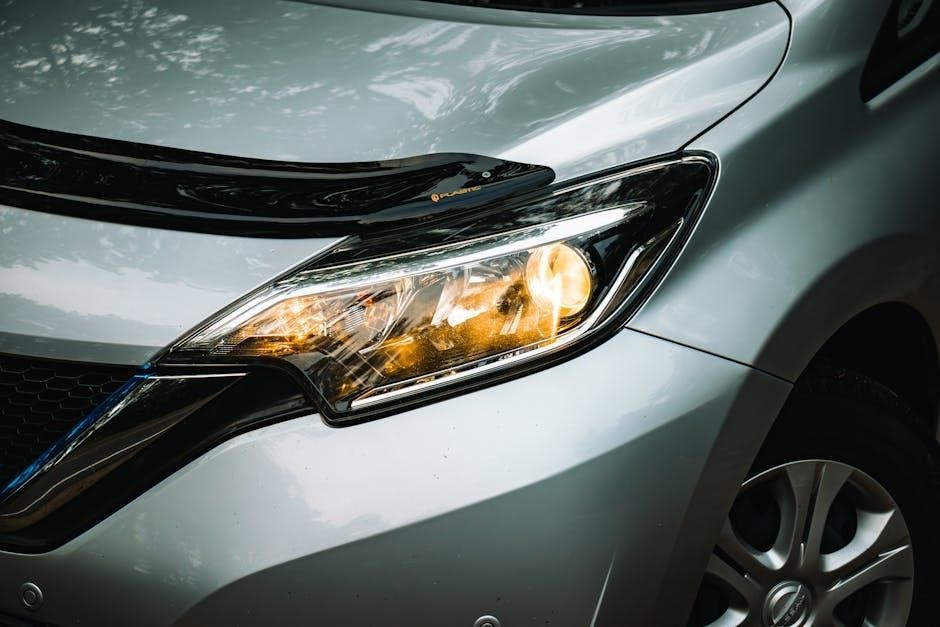
Overview of Headlight Bulb Types
Headlight bulbs come in various types, each offering distinct benefits; Halogen bulbs are the most common, providing warm yellow light and affordability, though they have a shorter lifespan. LED bulbs are energy-efficient, last longer, and produce a brighter, whiter light, enhancing visibility. HID (High-Intensity Discharge) bulbs, including Xenon types, emit intense light for superior brightness but may require time to warm up. Each type caters to different needs, whether prioritizing cost, longevity, or illumination quality. Understanding these options helps drivers choose bulbs that align with their vehicle’s requirements and driving habits. Proper selection ensures safety, visibility, and optimal performance on the road.
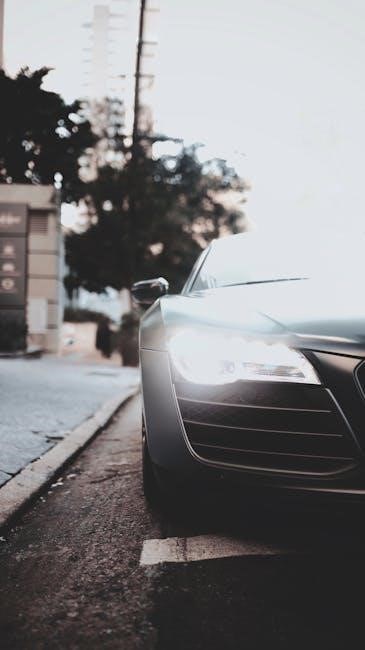
Types of Car Headlight Bulbs
Car headlight bulbs include halogen, LED, HID, and Xenon types, each offering unique benefits in brightness, energy efficiency, and lifespan, catering to different driving needs and preferences.
Halogen Bulbs
Halogen bulbs are the most common type of car headlight bulbs, known for their affordability and simplicity. They produce a warm yellow light, enhancing visibility in various driving conditions. With a lifespan of approximately 2,500 hours, they require frequent replacement compared to modern alternatives. Despite their shorter lifespan, halogen bulbs remain popular due to their low cost and wide compatibility with older vehicles. They are a reliable choice for drivers seeking a traditional lighting solution without upgrading to more advanced technologies like LED or HID bulbs.
LED Bulbs
LED bulbs are a modern and energy-efficient option for car headlights, offering superior brightness and a longer lifespan compared to traditional halogen bulbs. They emit a crisp, cool light typically around 6000K, closely resembling natural daylight, which enhances visibility and reduces eye strain. LED bulbs are known for their durability, lasting up to 50,000 hours, significantly outperforming halogen bulbs. Their low power consumption makes them an eco-friendly choice, reducing the strain on your car’s electrical system. Additionally, LEDs are resistant to vibration and shock, making them ideal for drivers who frequently traverse rough terrain. A key advantage is their “instant on” feature, providing immediate light for better reaction times. However, compatibility can vary, so it’s crucial to ensure they are designed for your vehicle’s headlight assembly to avoid issues like flickering or malfunctioning.
HID (High-Intensity Discharge) Bulbs
HID bulbs, also known as Xenon lights, produce a vibrant, intense light with a color temperature of around 4300K to 4500K, closely mimicking natural daylight. They generate light by exciting a gas within the bulb, resulting in a significantly brighter output compared to halogen bulbs. HID bulbs consume less power than halogen bulbs yet produce a light output that is up to three times greater, enhancing visibility and reducing eye strain for drivers. They also have a longer lifespan, lasting approximately 2000 to 2500 hours, making them a durable choice. However, HID bulbs are more expensive and may require a ballast to regulate the electrical current. Additionally, they often take a few seconds to reach full brightness and can sometimes produce glare for oncoming drivers if not properly aligned. Despite these drawbacks, HID bulbs are favored for their exceptional illumination and energy efficiency.
Xenon Bulbs
Xenon bulbs, often referred to as High-Intensity Discharge (HID) bulbs, are a popular choice for car headlights due to their exceptional brightness and efficiency. They produce a crisp, white light with a color temperature of around 4500K, closely resembling daylight. This enhances visibility and reduces eye strain while driving at night. Xenon bulbs have a longer lifespan compared to halogen bulbs, lasting up to 2000-2500 hours, and consume less power, making them energy-efficient. However, they require a ballast to regulate the electrical current, which can add to their cost. While they provide superior illumination, Xenon bulbs can sometimes cause glare for oncoming drivers if not properly aligned. They are widely used in luxury vehicles and are favored for their ability to deliver intense light output with minimal energy consumption. Proper installation and maintenance are essential to ensure optimal performance and safety.

How to Choose the Right Headlight Bulb
Selecting the right headlight bulb involves considering compatibility, brightness, lifespan, and energy efficiency to ensure optimal performance and safety for your vehicle.
Compatibility with Your Vehicle
Ensuring your headlight bulb is compatible with your vehicle is crucial for proper function and safety. Start by identifying your car’s make, model, and year to determine the correct bulb size and type. Use an automotive bulb finder tool or consult your vehicle’s manual to confirm the right fit. The bulb must match the socket type and wattage specified for your car to avoid electrical issues or poor performance. Incorrect bulbs may not fit securely, leading to reduced visibility or potential damage to the headlight assembly. Many modern vehicles require specific bulb technologies, such as LED or HID, which may not be interchangeable. Always check for compatibility before purchasing to ensure optimal illumination and safety on the road. Using the wrong bulb can compromise your ability to see and be seen by other drivers, making compatibility a top priority when selecting a replacement headlight bulb.
Brightness and Visibility
Brightness and visibility are critical factors when selecting car headlight bulbs, as they directly impact your ability to see the road and be seen by others. Different bulb types offer varying levels of brightness, with LED and HID bulbs generally providing greater illumination compared to traditional halogen bulbs. Lumens and color temperature are key measurements to consider; higher lumens mean brighter light, while color temperature affects the light’s tone, ranging from warm yellow to cool blue. Brighter, whiter light enhances visibility in dark conditions and reduces eye strain. However, excessive brightness can cause glare for oncoming drivers. Always choose bulbs that meet legal standards and suit your driving habits. Proper alignment and bulb quality also ensure optimal visibility. Upgrading to high-performance bulbs can significantly improve safety and driving confidence, especially in low-light environments. Balancing brightness and visibility ensures a safer and more comfortable driving experience.
Lifespan of the Bulb
The lifespan of a car headlight bulb varies significantly depending on the type and quality of the bulb. Halogen bulbs typically last around 2,500 hours, while LED bulbs can last up to 50,000 hours or more, offering superior durability. HID bulbs generally have a lifespan of about 2,000 to 4,000 hours. Factors such as filament quality, operating conditions, and driver behavior can influence how long a bulb lasts. Longer-lasting bulbs reduce the frequency of replacements, saving time and money. They also enhance safety by minimizing the risk of sudden bulb failure while driving. When selecting a bulb, consider its lifespan to ensure it meets your needs for reliability and performance. High-quality bulbs may cost more initially but provide long-term benefits. Always check reviews and specifications to make an informed decision. A longer-lasting bulb is a worthwhile investment for consistent illumination and safety on the road.
Energy Efficiency
Energy efficiency is a critical factor when selecting car headlight bulbs, as it impacts both performance and environmental impact. LED bulbs are among the most energy-efficient options, consuming significantly less power than halogen or HID bulbs while producing bright, clear light. This reduced energy consumption lowers the strain on your vehicle’s electrical system and can even improve fuel efficiency in conventional vehicles. Additionally, LEDs emit minimal heat, reducing energy loss and prolonging their lifespan. For electric vehicles, energy-efficient lighting is especially beneficial, as it helps maximize range. By choosing energy-efficient bulbs, drivers can reduce their carbon footprint and lower long-term operating costs. Modern bulb technologies are continuously advancing, offering improved efficiency without compromising on brightness or reliability. Opting for energy-efficient headlight bulbs is a practical and eco-friendly choice for any vehicle owner.
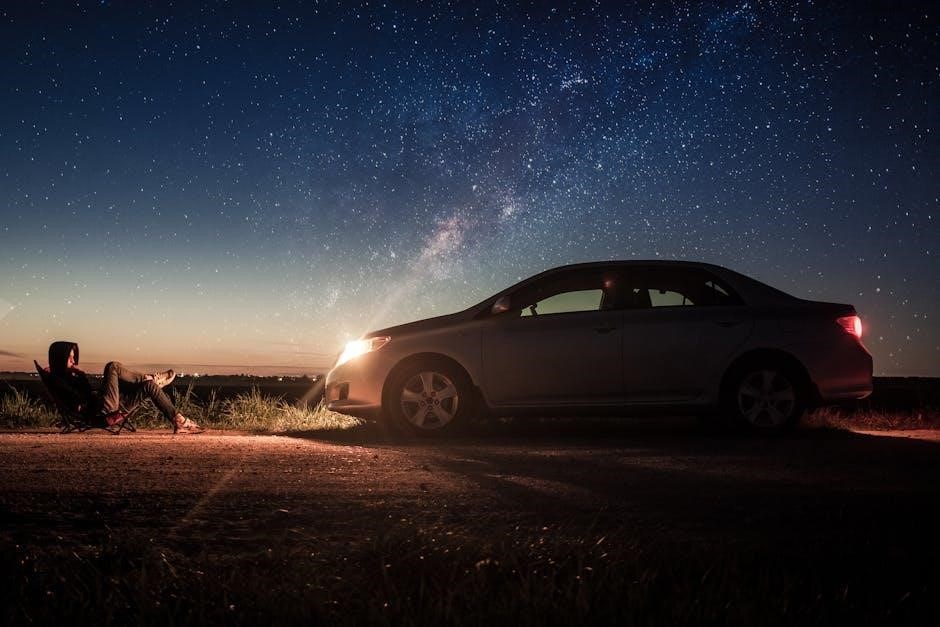
Replacing Your Car’s Headlight Bulbs
Replacing headlight bulbs ensures safety and visibility on the road. Use a bulb finder to identify the correct type for your vehicle, ensuring compatibility and optimal brightness performance.

When to Replace Your Headlight Bulbs
Replacing headlight bulbs is crucial when they show signs of wear, such as dimming, flickering, or discoloration. Dim or failed bulbs can reduce visibility and safety on the road, increasing the risk of accidents. If a bulb is blown, it should be replaced immediately to maintain proper lighting function. Additionally, if the glass appears hazy or the bulb’s brightness has significantly decreased, it’s time for a replacement. Regular inspections can help identify these issues early, ensuring your headlights remain effective and reliable. Always refer to your vehicle’s manual or a bulb finder guide to determine the correct replacement type for optimal performance and safety.
Step-by-Step Replacement Guide
Replacing your car’s headlight bulbs involves a few straightforward steps. First, ensure you have the correct replacement bulb using a bulb finder tool. Turn off the engine and let the bulb cool to avoid burns. Access the bulb by removing any protective covers or screws behind the headlight assembly. Gently pull the electrical connector away from the old bulb and remove it from the socket. Insert the new bulb, ensuring it fits securely, and reconnect the electrical connector. Replace any covers or screws you removed. Finally, test the headlights to confirm they are working properly. Always refer to your vehicle’s manual for specific instructions, as procedures may vary by make and model. Proper installation ensures safety and optimal visibility on the road.
DIY vs. Professional Installation
When it comes to replacing headlight bulbs, drivers often debate between DIY and professional installation. DIY replacement can save money and is generally straightforward for those with basic tools and mechanical aptitude. However, improper installation may lead to safety risks or bulb failure. Professional installation ensures the job is done correctly, with experts using specialized tools and knowledge to guarantee reliability and avoid potential damage to the headlight assembly. While DIY is cost-effective, professionals offer warranties and peace of mind. Ultimately, the choice depends on your comfort level with vehicle maintenance and the complexity of the replacement process for your specific vehicle. Always prioritize safety and visibility by ensuring the installation is done right, whether you tackle it yourself or seek professional help.

Maintenance and Care of Headlight Bulbs
Regular cleaning and proper handling are crucial for maintaining headlight bulbs. Avoid harsh chemicals, ensure secure installation, and inspect for damage to prevent premature failure and ensure optimal visibility.
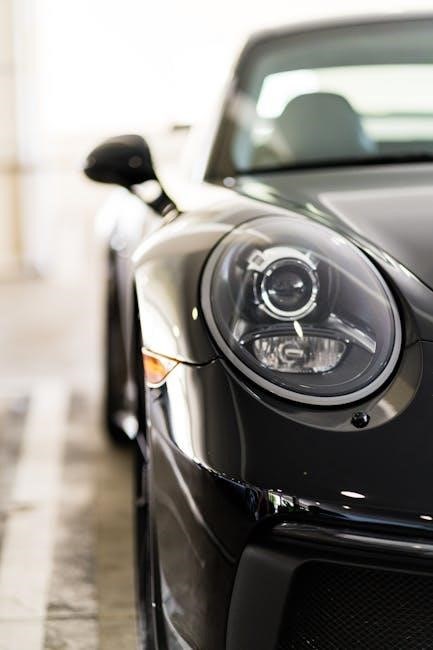
Cleaning Your Headlight Bulbs
Cleaning your car’s headlight bulbs is essential to maintain visibility and safety on the road. Start by turning off your headlights and allowing the bulbs to cool down to avoid damage. Use a soft, dry cloth to wipe away any dirt or debris from the surface of the bulbs. For more thorough cleaning, mix a small amount of mild soap with warm water, dip a microfiber cloth into the solution, and gently scrub the bulbs. Avoid using harsh chemicals, abrasive materials, or high-pressure washes, as these can damage the glass or protective coatings; For stubborn stains or yellowing, apply a small amount of toothpaste to a damp cloth and rub gently in circular motions before rinsing with clean water. Regular cleaning ensures your headlights remain clear and functional, providing optimal illumination while driving.
Aligning Your Headlights Properly
Properly aligning your car’s headlights is crucial for safety and visibility while driving. Misaligned headlights can cause glare for other drivers and reduce your ability to see the road. To align your headlights, start by ensuring your vehicle is on a level surface and the fuel tank is half full. Use a torque wrench to adjust the headlight assembly screws, typically located behind the headlights. Turn on the low beam headlights and measure the height of the light beam on a wall or garage door from 25 feet away. The beam should be slightly below the center of the headlight assembly. Adjust the screws to align the beams horizontally and vertically. For precise alignment, use masking tape to mark the center of the headlights and the target area. Test the alignment at night to ensure proper illumination and make adjustments as needed.
Protecting Bulbs from Damage
Protecting your car’s headlight bulbs from damage is essential to ensure longevity and performance. Always handle bulbs by their plastic base, avoiding direct contact with the glass to prevent oil from your skin causing premature failure. When installing new bulbs, use gloves or a clean cloth to minimize contamination. Regularly clean the headlight lenses to prevent dirt buildup, which can reduce light output and strain the bulbs. Apply a protective film or coating to the lenses to shield them from debris and UV damage. Avoid using high-pressure washes or abrasive cleaners, as they can scratch the lenses or damage the bulbs. Store spare bulbs in a cool, dry place, away from direct sunlight. Finally, ensure proper installation by following the manufacturer’s instructions to prevent overheating or electrical issues. Regular inspections can help identify potential problems before they lead to bulb failure.

Top Brands and Products for Headlight Bulbs
Top brands like Sylvania, Philips, and OSRAM offer high-quality headlight bulbs. Products such as Sylvania SilverStar and Philips Automotive provide superior brightness, energy efficiency, and durability.
Popular Brands in the Market
Several well-known brands dominate the automotive lighting industry, offering high-quality headlight bulbs; Sylvania, a trusted name, provides a range of options like the SilverStar series for enhanced brightness. Philips Automotive Lighting is renowned for its innovative solutions, including the CrystalVision and X-tremeVision lines. OSRAM stands out with its Night Breaker and LEDriving series, delivering superior visibility and durability. Hawkglow is another emerging brand, known for its energy-efficient LED bulbs. These brands consistently deliver reliable performance, making them favorites among car owners. Their products cater to various needs, from brightness and energy efficiency to lifespan and affordability. By choosing these reputable brands, drivers can ensure optimal lighting for safer and more comfortable driving experiences. Their advanced technologies and wide product ranges make them indispensable in the automotive lighting market.
Recommended Products for Different Vehicles
Choosing the right headlight bulb depends on your vehicle’s make, model, and lighting needs. For older models, Sylvania SilverStar bulbs are a popular choice, offering enhanced brightness and a longer lifespan. For luxury cars, Philips CrystalVision bulbs provide a stylish, crisp light with a modern aesthetic. Trucks and SUVs benefit from OSRAM Night Breaker bulbs, known for their superior visibility and durability. For energy-conscious drivers, Hawkglow LED bulbs are an excellent option, offering bright light with low power consumption. Each brand caters to specific needs, ensuring optimal performance. Always check compatibility using tools like the Automotive Bulb Finder to ensure the correct fit. Replacing bulbs in pairs is recommended for consistent light output. These products are trusted by drivers worldwide, providing reliable illumination for safer driving experiences.
This guide provides a comprehensive overview of car headlight bulbs, helping you make informed decisions. For further knowledge, explore resources like the Automotive Bulb Finder and detailed installation guides available online.
Final Thoughts on Headlight Bulb Selection
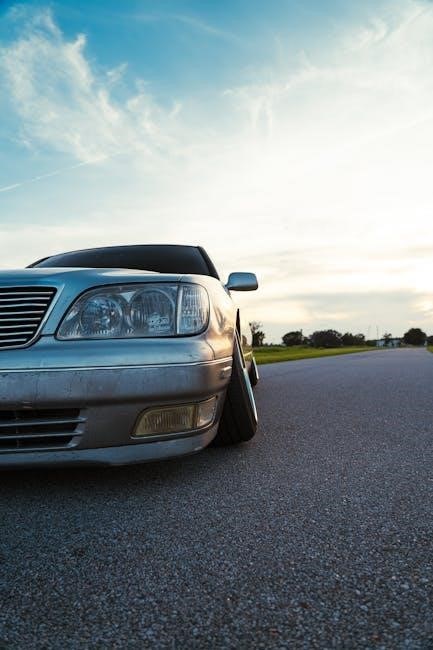
Selecting the right headlight bulb is crucial for safety, visibility, and driving comfort. Consider factors like compatibility, brightness, lifespan, and energy efficiency to make an informed decision. Halogen bulbs offer affordability and warm light but have shorter lifespans. LEDs provide bright, energy-efficient illumination with long durability, while HID bulbs deliver intense light but may require specialized fixtures. Use tools like the Automotive Bulb Finder to ensure the correct fit for your vehicle. Always replace bulbs in pairs for consistent performance and safety. If unsure, consult professional resources or guides for detailed advice. Proper maintenance and timely replacement can enhance your driving experience and ensure others on the road can see you clearly. Visit trusted automotive websites or consult experts for personalized recommendations tailored to your car’s needs.
Recommended Reading for Further Knowledge
For a deeper understanding of car headlight bulbs, explore resources like the Sylvania Bulb Finder and Osram Lamp Replacement Guide. These tools provide detailed compatibility charts and installation tips. Automotive websites such as AutoZone and Powerbulbs offer comprehensive guides on bulb types, brightness levels, and energy efficiency. Additionally, consult DIY repair manuals or videos for step-by-step instructions on replacing headlight bulbs for specific vehicle models. Forums like Reddit’s automotive community often share real-world experiences and recommendations. For advanced knowledge, read about the latest trends in LED and HID technologies. Lastly, refer to manufacturer-specific guides, such as the Philips Automotive Bulb Finder, to ensure you’re using the correct products for your car. These resources will help you make informed decisions and maintain your vehicle’s lighting system effectively.


